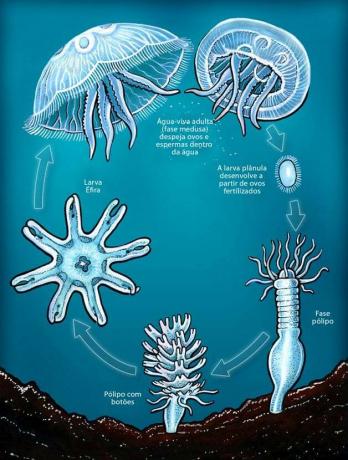A Jellyfish it is a Marine animal, also known as jellyfish, and has existed for approximately 650 million years. This animal has several species, and it is possible to discover new species of this family even today. Most are transparent and shaped like a bell.
The name medusa is given when the jellyfish reaches its adult stage, in which its final shape looks like a head full of curls, referring to the mythological figure that had snakes on its head.
see more
There are some dog breeds considered perfect for people…
Is it normal for cats to sleep on their owners feet? understand this behavior
structure of jellyfish
As we will see below, the physical structure of jellyfish it is very simple, composed mostly of water, without organs, bones or brain. Jellyfish are made up of:
- Epidermis – protects the internal organs;
- gastrodermis – inner layer of jellyfish;
- Mesoglea – intermediate gelatinous part, which is located between the epidermis and the gastrodermis;
- gastrovascular cavity – works as a set of the esophagus, stomach and intestine, all in one;
- Hole – functions as mouth and anus;
- Tentacles – are the extremities of the body.
The jellyfish is composed of nerves in the form of radial bundles that control the tentacles and that serve to identify light, detect presences, smell and orientate themselves.
jellyfish size
Jellyfish can vary greatly in size, as there are several types of species in the jellyfish family. cnidarians. Among them we can find small sizes that can reach 2.5 centimeters, and larger ones that can reach two meters in length.
reproduction of jellyfish

at the time of reproduction the male releases his sperm into the water through the hole, which, in turn, swims to the female reproduction hole, where fertilization occurs. In this way, it is possible to fertilize dozens of larvae at once.
After conception, the larvae leave the mother's body to settle on rocks, already in the structure of polyps. Polyps, in turn, are hollow structures with mouth and small tentacles. Later, jellyfish become ephyrae, which are structures like jellyfish.
However, they are in reduced format. Only after this stage does the jellyfish detach itself from the rock and become a jellyfish, living from three to six months.
Jellyfish Attack
Jellyfish have cells with toxic substances, which are used to capture their prey. The liquid in contact with the skin causes intense pain, called nematocysts, located mainly in the tentacles.
In direct contact with human skin, in addition to pain, the substance can cause symptoms such as: vomiting, headaches, head and abdominal pain, feeling of constriction in the throat, paralysis, convulsions and even insufficiency breathing. In addition, allergic reactions such as blisters, vesicles and even necrosis may appear on the skin.
See more details of others aquatic animals:
- Shark
- olive turtle
- Porpoise
